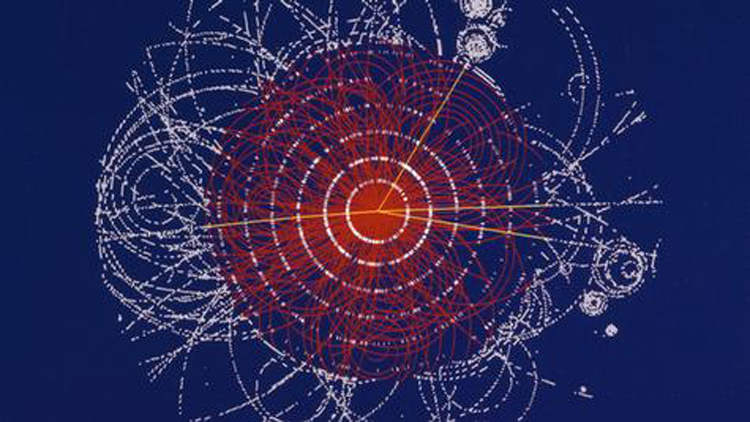by Petr Chylek (March 2025)

During the last few decades, there has been an effort to harmonize the Biblical account of creation with the evolving scientific knowledge, especially in the field of cosmology. Such effort was led mostly by theologians, religiously inclined philosophers, or just by common people interested in the process of evolution of our existence. Most physicists rejected any direct connection between the Big Band Theory and the creation as described in the Old Testament. However, those interested also in spiritual matters, found at least some degree of analogy between the two descriptions of the beginning.
In this note, I wish to point out two additional areas of possible analogy between the biblical description of creation and the recent, less than 100-year-old developments in physics. The two biblical verses I wish to relate to science are:
In the beginning, God (Elohim) created the heaven and the Earth (Genesis 1:1),
And a river went out of Eden to water the garden, and from thence it was parted and became into four heads (Genesis 2:10)
British physicist Peter Higgs died about a year ago, on April 8, 2024, at the age of 94. He was a theoretical physicist who, in 1964, together with his collaborators, predicted the existence of the last particle missing from the set of elementary particles to complete the scheme known as the Standard Model. The missing particle, known today as the Higgs boson, is responsible for other particles acquiring their masses. Until that time, the set of particles was almost complete, but with the major imperfection, all particles had theoretically zero mass. There was no known mechanism that could produce particles’ masses.
In popular books and other media, the Higgs boson is usually referred to as a God’s particle. The name has been adopted from the book of another particle physicist, Leon Lederman. The book titled God Particle was published in 1993. Most physicists did not like the nickname, and they stuck with the Higgs boson or Higgs particle.
In the first sentence of the Old Testament or Jewish Torah, we read that “In the beginning, God (Elohim) created the heaven and the Earth.” Heaven likely means a spiritual world without physical mass. However, the Earth is a physical object with a non-zero mass, and thus, a process to create the mass is needed. The same applies to the whole Universe. More specifically, all physical materials are composed of molecules which consist of atoms. Atoms, in turn, are composed of protons, neutrons, and electrons. Protons and neutrons consist of quarks. All these particles have definite mass. Any theory that cannot produce particles with mass is incomplete and cannot be considered correct, though it still can be useful.
The Standard Model of elementary particles is a Quantum Field Theory applied to particle physics. The fundamental objects in the quantum field theory are the fields, which are functions in space and time that have definite values at all points of space and time. Particles are created in the model as excitations of the fields. In an analogy you can consider the ocean as a field and the wave propagating on the ocean as an excitation of the ocean representing a particle.
In the original Standard Model, there were three fields. The field for particles, the field for forces, and the field for quarks. This original model explained the existence of observed elementary particles and the forces between them. However, the problem was that all particles in the model were massless. It was the Higgs’ field that gave them the mass. The excitation of the Higgs’ field is called the Higgs particle or Higgs boson. The bosons are elementary particles that carry energy and forces in the universe. They are elementary particles with integral spin (angular momentum).
The Higgs boson has a relatively large mass of about 130 proton masses, zero spin (angular momentum), and no electric charge. It has a very short lifetime of the order of sec-22, which means that the number of lifetimes in one second is a number of 1 followed by 22 zeroes. If we accept the Big Bang as the beginning of our physical universe, the Higgs boson existed only in a fraction of a second at the beginning of the Big Bang, when the temperature was very high. The Large Hadron Collider, located at the European Organization for Nuclear Research (Conseil Européen pour la Recherche Nucléaire), generally known as the CERN, on the border of Switzerland and France, was built to recreate the conditions present at the beginning of the Big Bang. Here, protons are accelerated to almost the speed of light, moving in opposite directions before they are made to collide with each other. The collision makes protons split into several other particles, occasionally containing a Higgs boson. Since Higgs boson has a very short lifetime (10-22 sec), it immediately decays to other particles. Its existence can be deduced only indirectly by analyzing the results of its decay.
When the Higgs boson was theoretically predicted in 1964, it was just a suggestion that such a particle with a large mass and predicted other properties should exist. For almost 50 years, searching for such a particle became the main project of several laboratories. Finally, in 2012, at the Large Hadron Collider at CERN, the Higgs boson was observed. The following year, the 2013 Nobel Prize for physics was awarded to Peter Higgs and François Englert “for the theoretical discovery of a mechanism that contributes to our understanding of the origin of mass of subatomic particles, and which recently was confirmed through the discovery of the predicted fundamental particle at the Large Hadron Collider at CERN.”
If the Higgs boson had not been discovered, all elementary particles would have been theoretically massless, and the whole theory would have been rejected. Regardless of how nice the theory is, if one observation violates the prediction, the theory has to be rejected.
According to the Big Bang theory, in the first split of a second, there was only one force in the universe, which immediately split into the four known forces: gravitation, electromagnetic, weak nuclear, and strong nuclear forces. In building an analogy with the Biblical creation, the following sentence may be considered: “And a river went out of Eden to water the garden, and from thence it was parted and became into four heads” (Gen 2:10). Rabbi Bachya (1255-1340) notes, in his commentary on the Torah, that Hebrew word NAHAR, meaning a “river,” could be confused with Aramaic (NAHARA), meaning the “light,” Thus, the Torah here does not necessarily speak about the rivers. It may be one beam of light entering the Garden and splitting into four light beams representing the four forces in our universe.
The quantum field theory explains the three basic forces: electromagnetic, weak nuclear, and strong nuclear forces. It does not include the gravitational force. Many attempts of combining all four forces, combining gravity (Einstein’s general theory of relativity) with the quantum field theory, remain unsuccessful. The graviton, the assumed particle connected to gravitational interaction, has not yet been observed. We probably have to wait another few decades or centuries before the Theory of Everything, the theory combining all four known forces, will be constructed.
The Jewish sages tell us that before the creation, there was only God; everywhere, all space was filled just by Him. Is this not similar to the state where we have just four quantum fields before any excitation? No particles, nothing, just the fields. Then, in the beginning, Elohim created the heaven and the Earth. Zero mass particles in heaven, and using the Higgs field, the particles with mass compose the Earth and the whole universe.
Here is a question. Does the recent development in quantum field theory have anything to do with the creation described in Genesis? The answer depends on your worldview. Are you an atheist? Then probably not. However, the agnostic or a believer may find some analogy.
Table of Contents
Petr Chylek is a theoretical physicist. He was a professor at several US and Canadian Universities. He is the author of over 150 publications in scientific journals. He thanks Lily A. Chylek and Daniel Spitz for their suggestions and comments on an earlier version of this article.
Follow NER on Twitter @NERIconoclast
- Like
- Digg
- Del
- Tumblr
- VKontakte
- Buffer
- Love This
- Odnoklassniki
- Meneame
- Blogger
- Amazon
- Yahoo Mail
- Gmail
- AOL
- Newsvine
- HackerNews
- Evernote
- MySpace
- Mail.ru
- Viadeo
- Line
- Comments
- Yummly
- SMS
- Viber
- Telegram
- Subscribe
- Skype
- Facebook Messenger
- Kakao
- LiveJournal
- Yammer
- Edgar
- Fintel
- Mix
- Instapaper
- Copy Link







One Response
I’ve been thinking about this a lot lately, all of our understanding of the universe is based on the mechanics of the electro magnetic spectrum. When it comes to the question of WHY the universe was created , all theories hit the same brick wall.
Maybe there’s another spectrum that we have yet to discover, one that will tell us why birds fly south in the winter, why , in the face of all of this logic, the human species is inherently illogical.
Even as we break down the composition of bosons we are no closer to understanding why we’re here.
An interesting thought came to me the other day. If the universe has no edge and no center and if time has no beginning and no end, then where YOU are at any given moment, is the exact center of everything